|

Beagle Proportions: The Beagle has a smooth, somewhat oval skull; a medium-length, square-cut muzzle; a black, gumdrop nose; large, hound-like hazel or brown eyes; long, velveteen, low-set ears (big); a medium-length, strong neck without folds in the skin; a broad chest narrowing to a tapered abdomen and waist; a short, slightly 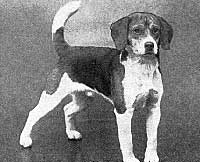 curved tail; an overall muscular body; and a medium-length, smooth, hard coat. One standard calls for beagles to be twice as long as tall, and twice as tall as wide. curved tail; an overall muscular body; and a medium-length, smooth, hard coat. One standard calls for beagles to be twice as long as tall, and twice as tall as wide.
Coloring: They appear in a range of colors, not limited to the familiar tricolor (white with large black areas and light brown spots). Two-color varieties are always white with colored areas, including such colors as "lemon," a very light tan; "red," a reddish, almost orangish brown; and "liver," a darker brown (liver is the only color not allowed in the British Standard). "Ticked" varieties may be either white or black with different colored spots ("ticking"), such as the bluetick beagle, which has spots that appear to be a midnight-blue color, similar to the Bluetick Coonhound. Some tricolor beagles also have ticking of various colors in their white areas.
Puppies: Beagles are almost always born black and white, with the brownish areas developing later. The brown is usually the last color to appear, taking sometimes 1-2 years to fully develop. Some beagles gradually change color throughout their lives. Beagles typically have a white-tipped tail, or "flag", which is important in locating them in the field due to their short height.
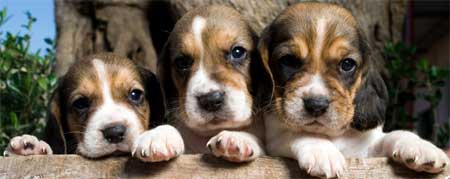
Two Kinds: The American Kennel Club and the Canadian Kennel Club recognize two separate varieties of Beagle: the 13-inch for hounds less than 13 inches, and the 15-inch for those between 13 and 15 inches. The Kennel Club (UK) and FCI affiliated clubs recognize a single type, with a height of between 13 and 16 inches. These standard dogs can reach 35 lb or more.
Pocket Beagle: In Medieval times, there was a breed called a pocket beagle, which stood at 8 to 9 inches. Small enough to fit in a "pocket" or saddlebag, they rode along on the hunt. The larger foxhounds would run the prey to ground, then the hunters would release the small beagles to continue the chase through underbrush into their burrows. Queen Elizabeth I often entertained guests at her royal table by letting her pocket beagles cavort amid their plates and cups. This genetic line is now extinct.

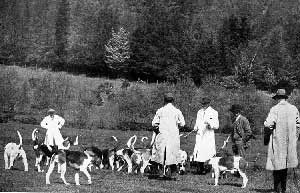 Howling Hunters: Beagles (or their ancestors) were originally used for hunting, and still are in some places. They appear to have been used for hare hunting in England as early as the reign of Edward III, who had a pack of up to 120 hare hounds with him on the battlefield during the Hundred Years' War. Beagling has been referred to as "the poor person's foxhunting," as a Beagle pack (30–40 dogs) is followed on foot, not horseback. The usual quarry is the hare. Beagles are admired by some for the bloodcurdling "Beagle music" they emit when in full pursuit, also called tonguing. Beagling, like foxhunting, is banned Howling Hunters: Beagles (or their ancestors) were originally used for hunting, and still are in some places. They appear to have been used for hare hunting in England as early as the reign of Edward III, who had a pack of up to 120 hare hounds with him on the battlefield during the Hundred Years' War. Beagling has been referred to as "the poor person's foxhunting," as a Beagle pack (30–40 dogs) is followed on foot, not horseback. The usual quarry is the hare. Beagles are admired by some for the bloodcurdling "Beagle music" they emit when in full pursuit, also called tonguing. Beagling, like foxhunting, is banned
in England.
In some countries, like Norway and Sweden, Beagles are used for hunting Hare, Roe Deer and in some cases Red Deer and Fox. In these countries Beagles are not used as a Beagle pack. The Hunter(s), strategically placed in the terrain, wait while the Beagle is chasing. The quarry tend to circle within a certain area while using one
dog, increasing the odds
for success
with few hunters.
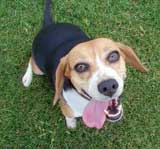 Personality to Spare: The Beagle has a very good temper and gentle disposition. Beagles are intelligent, but are stubborn and may be hard to train (due to their strong will). They are an especially loyal breed and are very friendly. They rarely show signs of aggression, and are excellent with children. They also get along with other dogs, provided that they have been socialized correctly. Personality to Spare: The Beagle has a very good temper and gentle disposition. Beagles are intelligent, but are stubborn and may be hard to train (due to their strong will). They are an especially loyal breed and are very friendly. They rarely show signs of aggression, and are excellent with children. They also get along with other dogs, provided that they have been socialized correctly.
Scent Hounds: They are playful and energetic dogs who enjoy long walks. Being scent hounds, if released, they may follow a scent endlessly or will incessantly try to tag along with other dogs regardless of cars, strangers, etc. They can be quite difficult to walk, especially when distracted by enticing smells. Because of their curiousity and spirited temperament, beagles are famed escape artists and humane societies and pounds often pick up stray beagles.
Pack Animals: Beagles are pack animals, and can be prone to separation anxiety. They are best kept with other dogs if they are going to be alone for long periods of time. A common misconception is that all Beagles howl incessantly. In reality, some are more vocal than others and some do not bark often at all. The breed has thousands of representatives and each has his or her own personality.

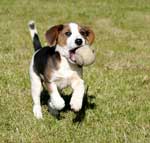 Health: Beagles are a healthy breed, often living for 12 to 15 years, but they do have a few common health problems. The Beagle's ears are long and floppy, which can trap warm moist air or prevent air from reaching the ear canals. This condition can be successfully treated with regular cleaning daily and sometimes medication for major cases. A good preventative measure is a diet consisting of lamb and rice dog food. Careless bathing can get water into their ears, potentially causing Health: Beagles are a healthy breed, often living for 12 to 15 years, but they do have a few common health problems. The Beagle's ears are long and floppy, which can trap warm moist air or prevent air from reaching the ear canals. This condition can be successfully treated with regular cleaning daily and sometimes medication for major cases. A good preventative measure is a diet consisting of lamb and rice dog food. Careless bathing can get water into their ears, potentially causing
ear infections.
Sometimes their eyelashes grow into the eye and irritate the eye, also known as distichiasis; this might require surgery to remove the eyelashes.
Obesity is a common health problem due to people overfeeding them in response to their playful and gentle behavior. Most will overeat if given the chance. A healthy Beagle should have some definition to its waist and have an hourglass appearance when viewed from above. You should be able to feel their ribs. Excessive weight can lead to problems such as hip dysplasia and heart trouble. They need exercise and a good diet.
Some Beagles are prone to congenital heart disease. In some rare cases the breed may develop polyarthritis (where the immune system attacks the joints) even at a young age. This can be sometimes treated effectively with cortisone. They are also prone to seizures and epilepsy. This disease is treatable with medication. Some Beagles, like most dogs, are prone to various forms of Cancer, such as Lymphoma.
Beagle Background: In the eleventh century, William the Conqueror brought the Talbot hound into Great Britain. A white scent hound, the Talbot (now extinct) is thought to be a more recent ancestor of the modern-day beagle. The black and tan Irish Kerry Beagles are also considered another possible link in the evolution of early beagles. A small game hunter similar to the Bloodhound, Kerry Beagles may be the source of the strong scenting abilities of beagles today.
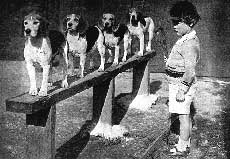 What's in a Name? The first mention of the beagle in English literature by name dates from 1475. The origin of the word "beagle" is uncertain, although it has been suggested that the word derives from the French begueule (meaning "open throat", or more colloquially, "loudmouth") or from an Old English, French, or Welsh term beag, meaning "small." Other possibilities include the French beugler (meaning "to bellow") and the German begele (meaning "to scold"). What's in a Name? The first mention of the beagle in English literature by name dates from 1475. The origin of the word "beagle" is uncertain, although it has been suggested that the word derives from the French begueule (meaning "open throat", or more colloquially, "loudmouth") or from an Old English, French, or Welsh term beag, meaning "small." Other possibilities include the French beugler (meaning "to bellow") and the German begele (meaning "to scold").
The Nose Knows: Beagles have superb noses and, despite their self-willed temperament, are sometimes used as sniffer dogs for drug detection. More often, though, they are the breed of choice of the United States Department of Agriculture to detect food items in luggage being transported into the U.S. The force is called the Beagle Brigade and these dogs wear a green jacket. Beagles were chosen because they are small and easy to care for, and because they are not as intimidating for people who are uncomfortable around dogs. They are also used for this purpose by the Ministry of Agriculture and Fisheries in New Zealand and by the Australian Quarantine and Inspection Service (for whom they wear maroon jackets).
Beagles in popular culture
* The Peanuts comic strip character Snoopy and his siblings are beagle mutts, i.e. mixes, rather than purebreds, though creator Schulz says that Snoopy (and his relatives) are mostly beagle. When Snoopy makes appearances at theme parks, he is billed as "The World's Most Famous Beagle."
* Buster in The Wonder Years.
* Poochie, the short-lived Itchy and Scratchy character, on The Simpsons.
* Porthos in Star Trek: Enterprise.
* Toby in Used Cars.
* Lou in Cats and Dogs.
* Buckley in The Royal Tenenbaums.
* Phyllis Reynolds Naylor's Shiloh trilogy is about a beagle.
* The Beagle Boys in Disney's DuckTales or Scrooge McDuck comics.
* Character Audrey fforbes-Hamilton has a Beagle in the BBC series To the Manor Born.
* According to Garfield, Odie is half-beagle and half-brick.
* Gromit from the animated cartoon Wallace & Gromit is a beagle.
* The Grape Ape had a friend named Beegle Beagle (also known as Beegley Beagley).
* In Three's Company, the characters frequented a restaurant called "The Regal Beagle."
* In "Where My Dogs At", Buddy is a Beagle.
* In the 1970's, singer Barry Manilow owned a Beagle named Bagle. Bagle appeared on the cover of Manilow's 1975 album, Trying To Get The Feeling Again.
* Mr. Peabody (of Rocky & Bullwinkle fame) is a beagle.
Famous beagles: US President Lyndon Johnson owned three Beagles named Him, Her, and Edgar.
All text is available under the terms
of the GNU Free Documentation License
|
